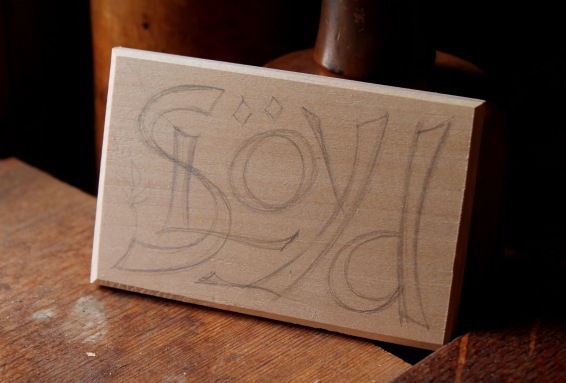
As I cut the letters into this small panel earlier this month, I was thinking back to Mr. Howard Sokoloff, my 8th grade woodshop teacher. Here was a man near retirement tasked with teaching every single thirteen-year-old in the school some hand skills. A lettered sign was one way to do it. I stumbled upon the one I made then while cleaning up recently. The memory of making this thing 35 years ago was strong, probably due to the thrill I felt at the time.

Mr. Sokoloff was a kind man. I remember his white hair Brylcreemed straight back above his horn-rimmed glasses as he guided us in the use of our main tools: coping saw, rasp, and sandpaper. After many class periods of shaping and smoothing our boards, we penciled on some lettering. There were a lot of names, house numbers, and pop bands. I liked fishing.
One by one, we’d take our boards to Mr. Sokoloff who fired up the router and did his best to follow our drawn lines as we surrounded him in amazement. It was a router, not a knife, but there were no computer programs or 3-D printers involved. Even though I didn’t cut the letters , I still had the satisfaction of designing them just by hand and eye with a pencil. Now I get the joy of drawing and cutting them.

Mr. Sokoloff never mentioned the word sloyd, but his instruction was indeed a remnant of a movement that had begun long before. This video provides a concise history from slöjd to sloyd:
P.S. — Here’s another recent lettering project that’s a bit different: a pottery stamp for a clay-working couple that sometimes collaborates on pieces. Something like 3/8″ high and 5/8″ wide. End-grain boxwood can hold some detail.

Some spoon handles next…

Thank you, David, for sharing that video. We have not only moved away from hand skills training in schools but also from handwriting, another skill that requires hand-eye coordination and which, some recent studies, I believe, have shown may have a role in fostering critical connections in our brains. Could there be a connection between the decreased emphasis on the development of hand-based skills, whether sloyd or writing, in our society and the growth of ADD, ADHD, Asperger’s Syndrome and other developmental issues?
LikeLiked by 1 person
I don’t know enough to speculate on much of that, Drew. But regarding the handwriting, it does seem to me that there are many benefits to the writer and beyond. Who doesn’t love receiving a hand-written letter via snail mail today?
LikeLiked by 1 person
One wonders how they will accomplish algebra without writing! They will soon tire after a step or two. You’d think we had proven a dot test is the best way to teach everyone everything. The wisdom of folly is infinite.
LikeLike
nice video and love the fishing sign–Sloyd sign’s not bad either–
LikeLike
That settles it then; my next project is a batch of those fishing signs.
LikeLike
Ah! Now, we see that you started stylized lettering early in life.
Thanks for the video about Sloyd. Oh, if only more people recognized the value of hand skills training. Instead, we have eejit (old-Irish for idiot) politicians telling us to “learn to code.” [Gheeeeesh]
Yep, like the new Sloyd sign
LikeLike
Yeah, Bob, it looks like I really tried to get the letters to fit the space. That G at the end was a stretch — and looks like Mr. Sokoloff was getting a little shaky on that one!
LikeLike
This was fun to read David. I hope somewhere in the country there are still shop classes going on. My Catholic elementary school in the 1980s bussed us to a nearby public school for wood, metal, sewing, and cooking shop. I often think of our metal shop teacher who let us warm and shape pieces of hot thermoplastic for candy dishes and jewelry. We had to polish the cut edges of the plastic, and I remember going to him eight or nine times, asking, “is this good enough?” He would laugh and send me back to work on it some more. It occurred to me that he was running down the clock and didn’t want anyone finished before the class period ended. But now I think it was a sloyd lesson: if I have to ask, then it isn’t good enough. Peace, Dave!
LikeLike
Thanks for sharing that story, Matthew. Good lesson. Reminded me of ninth grade. In our ninth grade metal shop, we arc welded. Our shop teacher had to be laughing inside as kids emerged, one after another, from the curtained-off welding area holding up globs of misshapen steel with welding rods stuck to them. “Good enough?”
LikeLike
Hand work informs us of each other. What’s more beautiful or necessary than that?
LikeLike
Aye; lovely. Thanks Scott.
LikeLike
Beautiful post Dave. As it just so happens I’m reading through shop as soul craft now. And I love that video. I never knew that the north Bennett school was where shop class started in the United States. Makes me think about my summers as a grad student and first few years as a teacher when I took a job as a bicycle mechanic. I found that work so enriching and restorative. Too much intellectual labor during the year needed some balance of handwork.thanks again.
LikeLike
That’s a good book, Eric. I’ll have to look back through it myself.
LikeLike
So you caught the typography bug quite early! Well done. Beautiful work on the pottery stamp. Is carving the end-grain “tricky”?
LikeLike
Not so much tricky, Chris, but different. There’s no grain running to pull the knife this way or that. Boxwood is relatively hard, but it is amazingly fine-grained. A really nice guy gave me a bunch of branch pieces that have been drying for years.
LikeLike